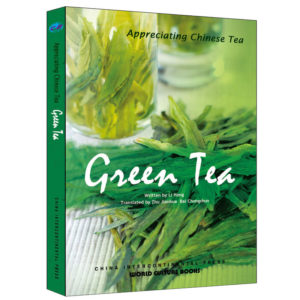Description
Author: Hong Li
Publishing house: China Intercontinental Press
Edition: 1 (Jan. 2010)
Page: 160
Format: 32
Preface:
Since the first cup brewed almost 5,000 years ago, green tea’s popularity has increased to the point that it is presently the second most popular beverage in the world. As the name suggests, the tea is green in color.
At first glance, all brewed tea appear the same, but a connoisseur is able to identify the different varieties of green tea through the appearance and color of the dried tea–the flat Long Jing tea; the snail shell-like outwardly curling Bi Luo Chun tea and the bamboo-green Zhu Ye Qing, all tell their own stories.
Abstract:
Why is tea the National drink of China? Why is tea regarded as symbolizing the harmony and mysterious unity of the Universe? Why is the loose-leaf Chinese tea more beneficial than the tea bags? How many types of Chinese tea are Available? How to make the best cup of Chinese tea? ……A visitor to the home of tea has so many questions. Understanding their answers will bring you closer to the history and mystery of tea. Appreciating Chinese Tea Series will help you.
Content:
PART 1 Introduction to Green Tea
I. Production Areas of Green Tea
II. Classification of Green Tea
IV. Processing Green Tea
Column 1. Organic Tea
PART 2 A Survey of Famous Green
Teas in China
I. Famous Green Tea in Zhejiang Province
II. Green Tea in Jiangsu Province
Column 2. Quality Safety Certification
III. Green Tea in Anhui Province
IV. Green Tea in Sichuan Province
V. Green Tea in Henan Province
VI. Green Tea in Jiangxi Province
VII. Green Tea in Hunan Province
Column 3. Green Tea Storage
VIII. Green Tea in Shandong Province
IX. Green Tea in Guizhou Province
X. Green Tea in Shaanxi Province
Column 4. Fu Xi Tea Varieties
XI. Green Tea in the Guangxi Region
XII. Green Tea in Yunan Province
Column 5. Green Tea in Japan
PART 3 Reprocessed Green Tea
I. Scented Tea
Column 6. Jasmine Tea
II. Compressed Green Tea
III. Green Tea Extract
IV. Green Tea Bags
V. Beverages and Foods Containing Green Tea
Column 7. Ku Ding Tea
PART 4 Brewing Fragrant Green Tea
I. Six Key Factors for Brewing Green Tea
Column 8. Tea Polyphenols & Free Radicals
PART 5 Sensory Evaluation of Tea
Evaluating Green Tea
Issues Critical to Green Tea Evaluation
Preview:
I. Famous Green Tea in Zhejiang Province
Located south of the Yangtze River tea production area, Zhejiang Province is an important base for green tea production. Tea plantations include Jiaxing, Hangzhou, Huzhou, Shaoxing, Yuyao, Jinhua, Cixi and Quzhou. The major famous green tea brands include Xi Hu Long Jing, Da Fo Long Jing, White An Ji, Chang Xing Zi Zhu, Jing Shan, Hu Ming, Xue Shui Yun Lu, Ling Hai Pan Hao, Yan Dang Mao Feng, etc.
1. Long Jing Tea “Dragon Well Tea”
Known as the “Queen” of green tea for its “green color, strong fragrance, mellow taste and pretty contour,” Long Jing fresh green tea leaves are harvested before the Grain Rain of the Solar Term, and the typical sample of this tea is fl at, tastes sweet with a fragrance of leguminous fl owers. Traditional and modern high-quality Long Jing tea is completely manually roasted. Roasting of the Long Jing tea requires great attention and skilled hands during the tea-leaf processing. In 1757, visiting the South Yangtze area, Emperor Qianlong of the Qing Dynasty also commented upon the process of roasting in his poem The Song upon Inspecting the Tea Craftsmanship. Today, although roasting is usually performed with electric pans, the processing skills remain highly demanding. The harvested fresh leaves must be spread thinly on the ground to deactivate and roll (15 minutes); the deactivated and rolled leaves are spread for cooling and regaining moisture, ready to be sifted. Then they are desiccated and shaped in the pans. The desiccated crude tea is sifted and then re-roasted before the processed crude tea is sifted again to remove any residue fragments and dust. Finally, it is piled up and stored according to their grades.
Long Jing tea is a fl at, smooth and bright green leaf, with a mellow and refreshing taste and a light aftertaste. The liquid is clear and bright, pleasantly fragrant and with evenly immersed and settled tea leaves at the pot bottom (henceforth referred to as brewed leaves). Long Jing tea is produced in three areas, namely, Xihu, Qiantang and Yuezhou, with such famous brands as Xi Hu Long Jing, Qian Tang Long Jing and Yue Zhou Long Jing.
1. Xi Hu Long Jing (The West Lake Long Jing)
Lake Xihu, Longwu, Liuxia, Zhuantang and Zhoupu of Xihu district of Hang Zhou City are home to Long Jing tea and the famous Xi Hu Long Jing. Both the picked and the processed varieties are collectively named after the place of origin, Lake Xihu (the West Lake).
2. Shi Feng Long Jing
Shi Feng Long Jing is the best of Xi Hu Long Jing, which is the best among all Long Jing teas. It is also believed to be the most authentic Long Jing tea because of its place of origin from Long Jing town, surrounded by Mt. Shi Feng in the hilly Xihu District of Zhejiang Province.
3. Long Jing White
Long Jing white tea actually belongs to a green tea variety locally known as “Long Cha,” mainly produced in the Anji and Pang’an counties of Zhejiang Province. Using the technique of Long Jing, the tea is processed from the fresh white tea leaves from local tea plantations…





























